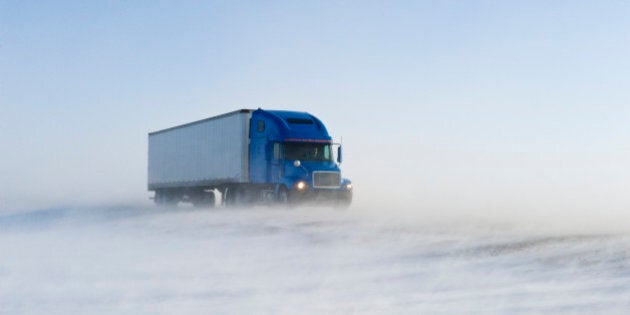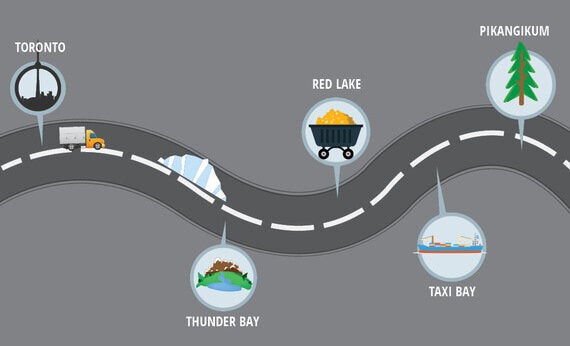
The OAFB distributes fresh, frozen and non-perishable food to its 125 direct member food banks across the province. From urban centres, to rural communities, to the far corners of the North, there are very few areas of the province that are not served by one of our member food banks.
This past year, the OAFB distributed more than seven million pounds of food to these agencies, including fresh eggs, meat, milk and produce, or the equivalent of five million meals.
Sound distribution is of the utmost importance to the OAFB as it is what ensures that children do not have to go to bed hungry; students do not have to choose between buying books or having dinner; and that senior citizens do not have to choose between heat and food throughout the winter.
Food banks across Ontario rely on the OAFB to ensure effective and efficient food delivery so that they can continue to confidently provide front line service to their clients.
Serving an area as large as Ontario, however, is not without its challenges. Take, for example, the recent 2,000-kilometre distance that a shipment of food took to Pikangikum, a small First Nations community in Northwestern Ontario with an estimated 90 per cent unemployment rate.
Pikangikum is a remote First Nations community with a notoriety of challenges well beyond those of its neighbours: lack of potable water, unprecedented suicide rate among its youth, social unrest, addictions and epidemic levels of health issues, such as diabetes.
The closest OAFB member to Pikangikum is the Regional Food Distribution Association (RFDA) in Thunder Bay. This food bank, which delivers food throughout Northwestern Ontario, is always looking for opportunities to source nutritious food for the health team that serves the Pikangikum community -- a job they do with both passion and professionalism.
The OAFB regularly ships food 1,400 kilometres to Thunder Bay; however, getting food into Pikangikum is a project unto its own. As a fly-in community that is only accessible by airplane, ice roads, or boat, delivering much-needed food requires innovation, careful planning, and a dedicated group of people committed to ensuring the safe arrival of the delivery. This is where the RFDA steps in.
Getting food into Pikangikum has a sense of urgency, as there is a narrow window of time when the RFDA is able to safely deliver food to the community before the winter freeze sets in. Both the Health Centre and School Meal Program are desperately in need of food, and cannot wait an additional two months until the ice roads fully form.
This fall, the RFDA made a trip to the remote reserve to ensure that it would have enough food for the upcoming winter months. The delivery included fresh, frozen and non-perishable products such as fruit, vegetables, frozen meats and bulk staples like rice, flour, oatmeal, sugar and baking powder.
Prior to the trip, volunteers spent hours packing and repacking the food hampers in order to maximize capacity and ensure food preservation for the long trip ahead. Once the hampers were ready, the RFDA loaded the refrigerated trailer of the Executive Director's four-wheel drive truck with the food for Pikangikum.
The first leg of the trip was a 560 kilometre drive to Red Lake, which took about seven hours with unusually good driving conditions. It is here that the staff and volunteers of the RFDA spent the night, taking turns running the refrigeration unit and monitoring its temperature every few hours.
It is also here that they had to wait for the right time to drive up the Nungesser Road, a gravel forest-access road en route to Taxi Bay and the turn-off to Pikangikum. A twisting, washboard-riddled trail, travelling this portion of the trek with a fully-loaded trailer was particularly slow.
The timing to Taxi Bay had to be perfect, as the RFDA's arrival had to coincide with the arrival of the barge that was to take the Executive Director's truck and trailer the final leg of the journey across Pikangikum Lake. The barge is run by a private enterprise and can cost up to $1,000 per trip. Missing the narrow window of opportunity was not an option, as this was the last chance to make the food delivery before the winter freeze.
Upon arrival in Pikangikum, the RFDA waited with its trailer until it was empty, before making the long trek back home.

This is standard food distribution for the RFDA. There are countless challenges, but the food bank continues to find solutions. This story is unique to delivering food to this community, but the dedication and care shown is something found in all of Ontario's food banks. Hundreds of food bank staff and volunteers strive on a daily basis to meet almost impossible needs with insufficient resources, and always with their clients in the forefront of their minds.
The role of the OAFB is to help them meet these challenges by providing additional resources to assist. Whether it is setting up the first leg of the journey for a food delivery, as with the RFDA, or providing them with nutritious food they may otherwise not be able to access, distribution is key to these services.
Like our food banks, the OAFB is continually evolving provincial programming to adapt to the ever-changing needs of member food banks and the clients they serve.
The OAFB has focused over the past three years on building fresh food programs in partnership with Ontario's agricultural sector to ensure that all Ontarians have access to the healthy food they need to learn, play, work, and grow.
The OAFB is pleased to say that for the second year in a row, more than 50 per cent of food acquired and distributed has been either fresh or frozen. Truckloads of healthy food including potatoes, ground beef, cabbage, eggs and even organic, local rainbow trout were distributed across Ontario to directly support those who needed it most. This year, provincial farmers, food processors and food transporters helped to provide Ontario's food banks with:
• Almost one million litres of fresh milk
• Over 144,000 dozen eggs
• 45,500 servings of Ontario beef
• 33,500 servings of Ontario turkey
• 30,100 servings of Ontario pork
• Over one million pounds of perishable food including fruits and vegetables
On behalf of the provincial food bank network, the OAFB truly thanks its partners for their generous and ongoing contributions throughout the year.
To help support the initiatives of the OAFB, please donate today at www.oafb.ca/donate!
MORE ON HUFFPOST:
